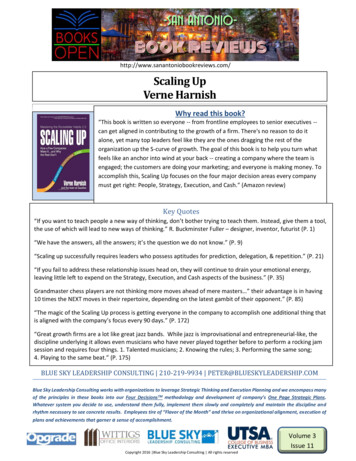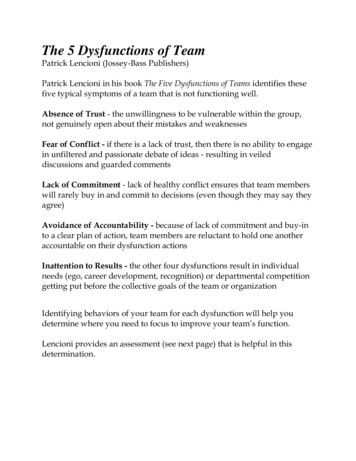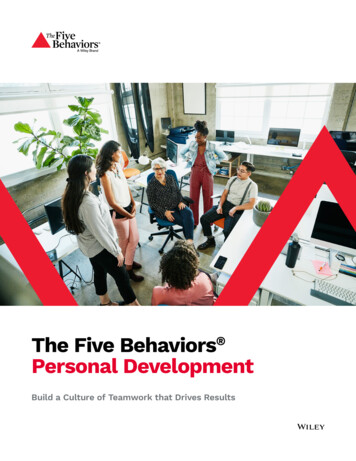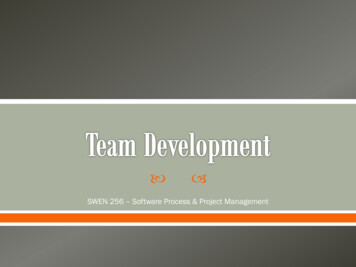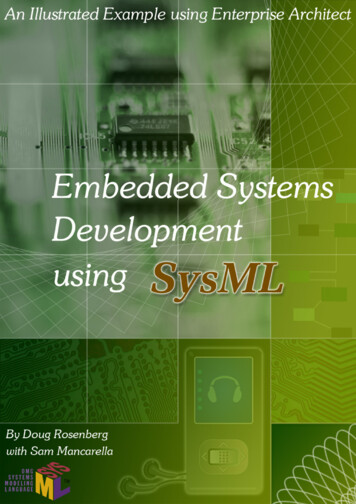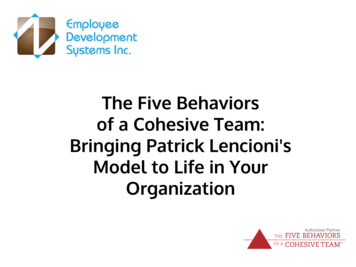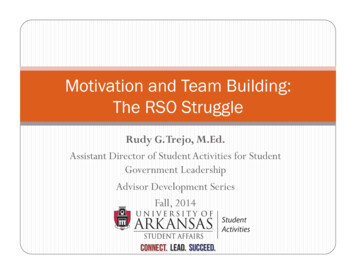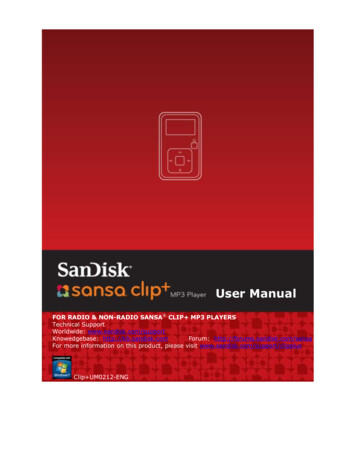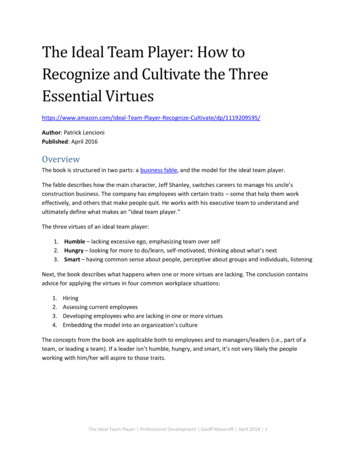
Transcription
http://www.sanantoniobookreviews.com/Ideal Team PlayerPatrick LencioniWhy read this book?“Patrick Lencioni turns his focus to the individual, revealing the three indispensablevirtues of an ideal team player.In The Ideal Team Player, Lencioni tells the story of Jeff Shanley, a leader desperateto save his uncle’s company by restoring its cultural commitment to teamwork. Jeffmust crack the code on the virtues that real team players possess, and then build aculture of hiring and development around those virtues.Beyond the fable, Lencioni presents a practical framework and actionable tools foridentifying, hiring, and developing ideal team players.” (Goodreads.com))Key Quotes“The ability to work effectively with others, to add value within the dynamics of a group endeavor, is morecritical in today’s fluid world than it has ever been. Few people succeed at work, in the family, or in any socialcontext without it.” (P. ix)“We could get more work done with fewer people if we had real team players.” (P59)“Oh crap. We let the jackasses hire more jackasses.” (P. 60)“The most unhappy people in a company are the ones who don’t fit the culture and are allowed to stay. Theyknow they don’t belong. Deep down inside they don’t want to be there. They’re miserable.” (P. 61)“No matter what happens, and what challenge we might face, give me a roomful of people who aren’t jackasses,and I’ll be happy to take it on.” (P. 151)“I’ve found that, in most cases, managers greatly underestimate the impact that a coment or quick gesture ofapproval has on employees.” (P. 210)“Great cultures tend to be appropriately intolerant of certain behaviors, and great teams should be quick andtactful in addressing any lack of humility, hunger, and people smarts.” (P.211)BLUE SKY LEADERSHIP CONSULTING 210-219-9934 PETER@BLUESKYLEADERSHIP.COMBlue Sky Leadership Consulting works with organizations to leverage Strategic Thinking and Execution Planning and we encompass manyof the principles in these books into our Four DecisionsTM methodology and development of company’s One Page Strategic Plans.Whatever system you decide to use, understand them fully, implement them slowly and completely and maintain the discipline andrhythm necessary to see concrete results. Employees tire of “Flavor of the Month” and thrive on organizational alignment, execution ofplans and achievements that garner a sense of accomplishment.Volume 3Issue 12Copyright 2016 Blue Sky Leadership Consulting All rights reserved
http://www.sanantoniobookreviews.com/Ideal Team PlayerThis is a book about1. The three virtues of an Ideal Team Player2. How to apply the model to your organization3. Connecting the Ideal Team Player with the Five Dysfunctions of a Team ModelPart One: The FableJeff ShanleyCEO (son of Robert)Clare MassickBobby BradyField OperationsHR, Finance, LegalKimOffice ReceptionistCraigCodyProject ManagerNancy MorrisFinance ManagerForemanVP Field OpsBrandonForemanProject ManagerCarlNew Hire TedMarchbanksPedroForemanThe fable lends some practical application thoughts and ideas to the model and brings to life the conceptspresented in the model. However, if you just want to get the facts and nothing but the facts turn to thesecond half of the book for the details.Book Review: Ideal Team PlayerPage 2 6Volume 3Issue 12
http://www.sanantoniobookreviews.com/The ModelThe Three Virtues of an Ideal Team PlayerVirtue – a synonym for the nouns quality and asset which connotes the idea of integrity and morality. (P. 155)HumbleHungrySmart Lacks excessive ego orconcerns about status Shares credit Defines successcollectively rather thanindividually The single greatest andmost indispensibleattribute of being a teamplayer Always looking for more.more things to do. Moreto learn. Moreresponsibility A manageable andsustainable commitmentto doing the job well andgoing above and beyondwhen it is truly required. Hungry people almostnever have to be pushedby a manager to workharder because they areself-motivated anddiligent. Refers to a person'scommon sense aboutpeople. It has everythingto do with the ability tobe interpersonallyappropriate and aware. They have goodjudgment and intuitionaround the subtleties ofgroup dynamics and theimpact of their words andactions. Smart simply refers to aperson's common senseabout people.What makes HUMBLE, HUNGRY,and SMART powerful and uniqueis not the individual attributesthemselves, but rather therequired combination of all three.(P.161)The HistoryLencioni provides some interesting insights about when he and his partners founded the Table Group. Thesewere, and still are, their core values but were always used internally only. It was later that they realized thatthese were the missing links for their customers in being able to apply the concepts in the Five DysfunctionsModel more effectively.Book Review: Ideal Team PlayerPage 3 6Volume 3Issue 12
http://www.sanantoniobookreviews.com/The CategoriesWhat you get when someone has none, some or all the characteristics of an Ideal Team Player0 for 3Little chance ofbeing teammembers.Generally easyto identify1 for 3An uphill battle but notimpossible.2 for 3Harder to identifyEasier to become ideal teamplayersHUMBLE:The PawnHUMBLE and HUNGRY:The Accidental Mess-MakerPleasant, kind-hearted;don’t make waves,little impact onperformanceHUNGRY:The BulldozerWant to serve teamLack interpersonal skillsOthers have to clean up messLeast dangerousHUMBLE and SMART:The Lovable SlackerGet it done; focus onself; team destroyers;easily identifiedAdept at working with othersDo only what is asked andrarely seek work or volunteerLimited passion but charmingand positive;Need significant oversightHUNGRY and SMART:The Skillful PoliticianSMART:The CharmerEntertaining/likeableNegligible contributions3 for 3They have little ego,share accolades; workwith energy, passion,and personalresponsibility; they sayand do the right thingsCleverly ambitious and hardworkers if it benefits them.Can PORTRAY humbleness;Create trail of destruction;Created where rewards are forindividuals over teamworkWarning11.2.3.4.5.1It is difficult to accurately identify peopleLabeling a person incorrectly can be damagingDO NOT label Ideal players just because they are relatively stronger in one of the three areasLabels apply ONLY for those significantly lacking in one of the three traitsThe goal is to recognize then develop team membersLencioni, Patrick The Ideal Team Player, copyright 2016, page 172Book Review: Ideal Team PlayerPage 4 6Volume 3Issue 12
http://www.sanantoniobookreviews.com/Using the Model1. Hiring (pages 174 – 186)a. Don’t be generic; develop specific questions that will reveal as much as possibleb. Debrief after EACH interview so future interviews can focus on questionable areasc. Group interviews allow for even better debriefsd. Use nontraditional interviews e.g. business trip, run an errand together, etc.e. Ask questions more than once in slightly different ways.f. Ask what others WOULD sayg. Have them do some real workh. Don’t ignore hunches – keep diggingi. Scare people with sincerity – tell them what will be expected and what accountable for.j. Use references2. Assessing current employeesa. Confirm that they are an ideal team playerb. Help the employee to improve and become onec. Decide to move the employee outd. Have the employee do a self-assessmente. See the book for questions to ask for the manager assessment3. Developing employeesa. KEY: once started the manager MUST constantly remind employee when not doing what isneeded. The result: a break THROUGH or a break DOWNb. Don’t forget to help the Ideal Team Players develop even stronger attributesc. The book outlines some of the tools and resources for developing each of the traits4. Embedding the model into your culturea. Teamwork is a choice and it is up the leaders to start by being clear of expectationsb. Reinforce your culture by ‘catching’ people doing what you want them to do and callingattention to those behaviors.c. When you see behaviors violated, let them know – even the smaller offensesConnect your Ideal Team Player Model with Five Dysfunctions of a TeamUse the Team Player model to tune up your 5 Dysfunctions methodology. As team members step up theirgame they become better together as a team and can apply the team principles more effectively.Book Review: Ideal Team PlayerPage 5 6Volume 3Issue 12
http://www.sanantoniobookreviews.com/Calendar of EventsSan Antonio – Wittigs8:00 – 9:30 AMUTSA EMBA Alumni7:30 – 8:45Dec 16Jan 27Ideal Team PlayerFuture CrimesJan 6Feb 3Feb 24The inevitable: 12 techforces shape futureHunting in a FarmersWorldGrit: The power ofpassion & perseveranceEntreLeadershipMar 3Mar 24Apr 28May26Jun 23Jul 28Aug 25Sep 22Oct 27Nov 17Dec 15Apr 7May 5Jun 2Houston – Wittigs11:30 – 1:00Future CrimesThe inevitable: 12 techforces shape futureHunting in a FarmersWorldGrit: The power of passion& perseveranceEntreLeadershipDec 22Jan 26Ideal Team PlayerFuture CrimesFeb 23The inevitable: 12 techforces shape futureMar 23 Hunting in a FarmersWorldApr 27 Grit: The power ofpassion & perseveranceMayEntreLeadershipSecrets of theMillionaire MindProcrastinate onPurposeDaring GreatlyJul 7Secrets of the MillionaireMindProcrastinate on PurposeAug 4Daring GreatlyJul 27Secrets of the MillionaireMindProcrastinate on PurposeSep 8Aug 24Daring GreatlyBetter than Before:what I learned aboutm/b habitsEgo is the EnemyLeaders Eat LastWinningOct 6Better than Before: what Ilearned about m/b habitsEgo is the EnemySep 21Nov 3Dec 1Leaders Eat LastWinningOct 26Nov 16Dec 14Better than Before: whatI learned about m/bhabitsEgo is the EnemyLeaders Eat LastWinningOurPeter“Faculty” BraeulerMarkWittigMalcolmCombsRobertSchmidt25Jun 22JudyZimmermanAndrewWittigOur SupportersBook Review: Ideal Team PlayerPage 6 6Volume 3Issue 12
Ideal Team Player This is a book about 1. The three virtues of an Ideal Team Player 2. How to apply the model to your organization 3. Connecting the Ideal Team Player with the Five Dysfunctions of a Team Model Part One: The Fable The fable lends some practical application thoughts and ideas to the model and brings to life the concepts
